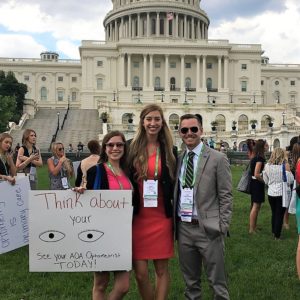We’ve all heard it before: “optometry is a legislated profession.” But what does that really mean?
Put simply, if an optometrist wants to do something, there has to be a law that explicitly states that they can. If your experience in optometry school is anything like mine, you are constantly being reminded of the legislative nature of optometry. But what can we do as students to make a difference? Here are five easy things you can do today to ensure that our profession is a strong one when we graduate.
1. Know the past
The best way to get motivated to be involved is understand what’s at stake. We all get a taste of the history of optometry in first year, but we must realize that every law that has been fought for can be amended or voided by additional laws. A great resource to learn more about the laws that have made optometry stronger is available here.
2. Attend the advocacy conference
I’m a big fan of this one. I have been fortunate enough to attend the Congressional Advocacy Conference (CAC) every year since starting optometry school, and it is the best place to see the hard work of the AOA in action. Optometrists and students from all over the country meet in Washington D.C. to meet with lawmakers. The goal is to educate and inform them on some of the biggest issues impacting our patients and our profession. Many lawmakers are simply too busy to do in depth research on every issue, so they rely on their constituents to inform them of the issues that they care about. If you are interested in attending CAC 2018, you can find more details here.
3. Be an “optocrat“
Once you start to understand a little bit about what advocacy means in optometry, it’s time to start being an optometry advocate. This doesn’t necessarily mean you have to travel to Washington D.C. to meet with legislators. It can also happen in your exam room while you are with your patients. For instance, according to the CDC, 40-90% of patients do not follow the care instructions for their contact lenses. The risk factors of not caring for contact lenses is one of the reasons why the FDA has classified them as a medical device requiring a prescription. Educating your patients on these facts can go a long way in making the profession a stronger one.
4. Be involved in AOSA
Sure, many of us our members of the American Optometric Student Association, but are we all really involved? If you aren’t a member of the AOSA, I highly encourage you to join. The AOSA is an amazing opportunity that most students don’t take advantage of; it is one of the best ways to understand what is going on in the profession. AOSA liaisons have direct contact with the AOA routinely, and thus can help you understand what they are doing to fight for you as a student and future optometrist. I encourage everyone reading this to find out who their liaison is and have a conversation with them about what the AOA is doing and what’s being fought for in the profession. To find out who your current liaisons are, check out this link.
5. Extra Resources
There are a ton of great resources on the web for you to learn more about the profession and what opportunities there are to advocate for optometry. Check out Advocacy Academy from Johnson & Johnson Vision, the AOA’s federal advocacy page, and AOA Focus magazine for more info. Finally, attend the local and state meetings in the area where you wish to practice. Attendance is usually free for students and these are fantastic networking opportunities in addition to being great places to learn about the issues that are facing the profession today.
It’s only a matter of time before the future of our profession falls into our hands. Let’s do everything we can to ensure that the future is a bright one!
Special thanks to J&J Vision for their continued advocacy for optometry and support of the AOA.


